How to Write a Linear Equation - Answers
The answers are in BOLD below.
NOTE: The transcript from the video is listed below the quiz for your reference.
1. What is the equation of the line with slope=2 and a y-intercept of -6?
- y=-2x+6
- -6x+2y=0
- 2x-6y=0
- y=2x-6
- y=-6x+2
2. If you knew that a line was perpendicular to y=3x+1, what would the slope of that line be?
- 3
- -1
- -3
- 3-Jan
- -0.333333333
3. What is the equation of the line through the points (2,4) and (-2, 6)?
- y=-2x+2
- y=2x+8
- y=-1/2x+5
- y=1/2x+3
- y=-2x
4. What is the equation of the line parallel to y=-4x+2 and through the point (-4,9)?
- y=1/4x+8
- y=4x-7
- y=-4x+25
- y=1/4x+10
- y=-4x-7
5.
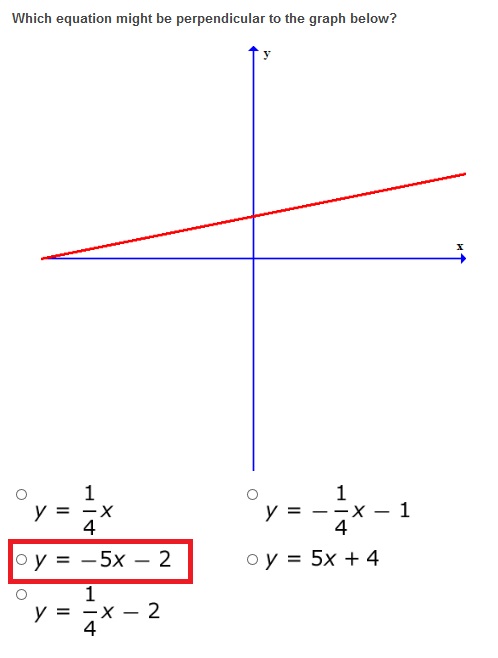
Simply knowing how to take a linear equation and graph it is only half of the battle. You should also be able to come up with the equation if you're given the right information.
A Mathematician's Needs
Mathematicians like to be thorough and find all the connections between things. So just being able to go from an algebraic rule to drawing the graph isn't really good enough for them. They want to be able to go the other way, too. Going from the graph to the rule isn't too bad because you can just pick out the information you need. But sometimes the picture isn't always going to be given and only small pieces of information will be given to you, and it's up to you to fill in the gaps.
Finding a Linear Equation
There's a lot of different kinds of information that could be given. The most common is that you'll be given two points. Maybe they'll ask you to find the equation of the line between the points (3,4) and (6,-2).
For any linear equation, the two things we need to know are the slope and the y-intercept. The slope is every time going to be the first thing we should try to find. Once we know the slope, it's a lot easier to find the y-intercept.
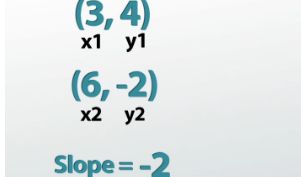 |
I personally like to find the slope when I'm given two points just using the logic that I know because I know the slope is the rise over the run, which means how much it goes up and down over how much it goes left and right. I know the rise is the change in y. So in this one, I see the y starting at 4 and going down to -2, which means the rise is -6. The run, the left and right, is x, and I see it start at 3 and go up to 6, which is a change of 3. And so I can get the slope right from this, which is -2.
A lot of people like using the formula, which is the x1, y1, x2, y2 formula. If you do it this way, you'll get the exact same answer. You plug in numbers y2 minus y1 over x2 minus x1 (y2 - y1 / x2 - x1). You do -2 -and get -6. And 6 - 3 = 3. And again, we end up with a slope of -2.
Like I said earlier, the two things we need are the slope and the y-intercept. We now know what the slope is, which means the y-intercept is the only thing left to find. Because I know m (-2) and because it gave us a sample x and y (3,4), I can substitute in everything I know and I'm left with an equation with only one variable in it (4 = -2 * 3 + b).
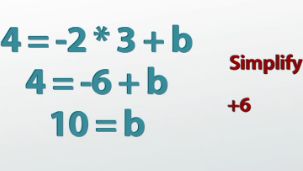 |
First, I do the operation it asks us to: -2 * 3 = -6. Then, I have to get the b by itself, which means I undo the -6. I undo subtraction with addition because of inverse operations. I end up with b = 10. Now that I know m and I know b, I'm done, and my answer is y = -2x + 10. That means that this linear equation begins at 10 and is decreasing by 2 every step of the way.
So that' s just one example of some information you may be given. But there's a lot of different things that could be given to you and we've only touched on one of those things.
Parallel and Perpendicular
Another very common thing to see is that instead of you getting two points, you only get one point, but they tell you that your line is either parallel or perpendicular to other sample line that they tell you. In order to solve this question, you have to know what the deal with parallel and perpendicular lines is. Parallel lines are two lines that kind of look like train tracks. They go in the same direction that ends up meaning that they have the exact same slope. They go over and up the exact same amount. So parallel lines have the same slopes.
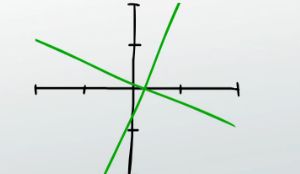 |
Perpendicular lines, on the other hand, are two lines that intersect each other at right angles. Perpendicular lines' slopes are what we call opposite reciprocals. One line is going over a lot, and up a little and one line is going over a little and down a lot. That has to do with the reciprocal part, which essentially means that if you have a fraction (1/4), you flip it (4/1).
So opposite reciprocals are numbers where one is positive (1/4) and one is negative (-4/1), and one is one fraction and the other is the flipped fraction. Don't forget to do both. It's really common to just make it negative or just make it positive, or forget to flip it or flip it but forget to change the sign. It's both.
Finding a Parallel Equation
Now that we know about parallel and perpendicular lines, we can answer questions like this that ask us, 'What is the equation of a line that is parallel to y = 3x + 2 and through the point (-3,6).'
Again, the two things we need to find are m and b, the slope and the y-intercept. We always want to find the slope first, so now I have to go about finding the slope in a slightly different manner than we did earlier. I can no longer use the slope formula, because it only gives us one point, so I have to use what I know about parallel lines.
 |
Luckily, we just learned that parallel lines have the same slope, which means that my slope is the exact same as this one, so I can just take the slope from this line (3) and just steal it and I already know the slope; all my work is done and I have half the answer to my question (y = 3x + b)
The other half that I still need is to find the b and I'm going to do this in the exact same way that we just did. I now know a sample x (-3), a sample y (6), I know what m is (3), all I have to do is find b. I can substitute in what I know (6 = 3 * -3 + b). I can solve the equation for b by doing inverse operations to get the b by itself, and we find that b = 15. Now that we know b and m, we have our answer, which is y = 3x + 15.
Solving a Perpendicular Equation
Similarly, you could be asked to find the equation of the line that is perpendicular to this one through this point. We've got the same equation (y = 3x + 2) and the same point (-3,6), but now instead of it being parallel, it's perpendicular.
I still need to find the m and the b, just like before, and again, I cannot use the slope formula because I only have one point. That means we use what we know about perpendicular lines and how their slopes relate. I know that the slope of y = 3x + 2 is 3, but because it's perpendicular, I can't simply steal that.
I have to first take the opposite reciprocal of it. The opposite part means that it changes from positive (3) to negative (-3). The reciprocal part means that it changes from -3/1 to -1/3. And now, we have the slope (-1/3) of our line, which means that we have half our answer (y = -(1/3)x + b) and all that's left to find is b.
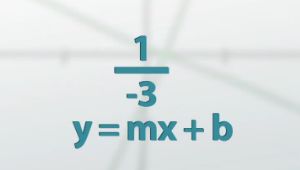 |
We find b in the exact same way we found b in every other problem in this video. We substitute in our sample x (-3), our sample y (6), what we know m is (-1/3) and we solve the equation for b (6 = -(1/3)(-3) + b). I multiply what I can and I undo to get b by itself, and this time we find that b = 5. This means my solution is y = -(1/3)x + 5.
Lesson Summary
To review, we learned that for any equation, we need to know what is the slope and what is the y-intercept. Once we know those two things, we're done and we can substitute them into y = mx + b.
The way we actually find m and b differs depending on the information that's given. We like using the slope formula (y2 - y1 / x2 - x1) if it gives us two points. Or, we might have to use what we know about parallel and perpendicular lines. We always find m first and then substitute in to find b.
You need to remember that parallel lines have slopes that are the same, whereas perpendicular lines have slopes that are opposite reciprocals.